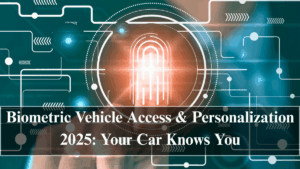In 2025, vehicles have evolved into intelligent companions that recognize, protect, and adapt to their drivers like never before. The fusion of biometric technology and artificial intelligence is transforming how drivers interact with their vehicles — replacing keys, passwords, and manual settings with personalized, secure, and seamless experiences. From facial recognition-based entry to AI-driven interior customization, the age of Biometric Vehicle Access & Personalization 2025 has truly arrived.
Gone are the days when you needed a key fob or smartphone to unlock your car. Now, your vehicle recognizes you. Whether through fingerprint sensors on door handles or facial cameras on dashboards, cars in 2025 instantly verify identity, adjust preferences, and prepare every system before you even step inside. This technology represents the perfect blend of security, convenience, and personalization — redefining what “ownership” means in the modern mobility era.

The Evolution of Biometric Vehicle Technology
Biometrics first entered the automotive world in premium models as a luxury feature. However, in 2025, it has become a mainstream automotive standard driven by rapid advancements in sensors, AI, and cloud connectivity. Today’s systems use a combination of facial, fingerprint, voice, and even iris recognition to authenticate drivers.
Manufacturers like Hyundai, BMW, and Tesla have integrated multi-modal biometric systems to ensure accuracy and speed. Hyundai’s “Face Connect,” for instance, allows users to unlock their vehicles using facial data, while BMW’s iDrive 9 ecosystem syncs biometric data with personalized profiles stored securely in the cloud.
This wave of biometric adoption not only simplifies access but also acts as an anti-theft safeguard, ensuring only verified users can start the vehicle or access sensitive features.
Security Meets Personalization
Biometric Vehicle Access & Personalization 2025 goes far beyond just locking and unlocking cars — it redefines the user experience through adaptive intelligence. Once a driver is authenticated, the vehicle automatically adjusts seat position, steering wheel alignment, infotainment preferences, and even ambient lighting based on their stored profile.
For shared vehicles or family cars, multiple profiles can be created, ensuring that every driver enjoys a unique and familiar environment. For instance, your preferred seat temperature, favorite playlist, and navigation preferences can be automatically loaded within seconds of entry.
Moreover, AI-driven learning algorithms enable the car to anticipate needs — such as setting route suggestions based on your daily commute or suggesting a charging stop when battery levels run low. This fusion of biometrics and AI marks the beginning of emotionally intelligent mobility.
Advanced Safety and Driver Monitoring
Safety is another domain being revolutionized by biometric technology. Cameras inside vehicles continuously monitor driver attention levels by tracking eye movement, facial expressions, and head position. If signs of fatigue or distraction are detected, the system issues alerts or gently adjusts environmental settings — such as lowering cabin temperature or playing a warning chime — to refocus the driver.
In semi-autonomous and Level 3 autonomous vehicles, biometric systems also serve as driver readiness verifiers. Before returning control to a human driver, the system ensures they are alert and physically capable of resuming command, minimizing risks during transitional phases of driving automation.
Data Security and Privacy Challenges
With biometric data at the heart of this innovation, privacy and cybersecurity have become crucial concerns in 2025. Automakers are implementing end-to-end encryption and on-device data storage to protect sensitive information from being hacked or misused.
For instance, fingerprint and facial templates are stored locally within the car’s secure processing unit rather than on cloud servers. This decentralization reduces vulnerability while maintaining quick response times. Manufacturers must also comply with global privacy regulations like the GDPR and ISO/SAE 21434 automotive cybersecurity standard, ensuring biometric systems meet stringent safety and ethical standards.
Integration with Connected Ecosystems
Biometric personalization extends beyond the vehicle itself. In connected car ecosystems, these systems synchronize with smart homes, smartphones, and wearable devices. Imagine walking toward your car — your smartwatch authenticates your presence, the car unlocks, climate control activates, and your home security system arms automatically as you drive away.
This seamless cross-device synchronization reflects the growing convergence between automotive and digital ecosystems. In ride-sharing or fleet operations, biometric ID ensures accountability and transparency, confirming that only registered users access the vehicle. This is particularly valuable in autonomous taxi fleets, where contactless verification is critical for trust and safety.
The Road Ahead: Emotionally Aware Mobility
Looking toward the future, Biometric Vehicle Access & Personalization 2025 is only the beginning of emotionally aware vehicles. Research is already underway on systems capable of detecting driver stress, mood, and health indicators through biometrics. Future vehicles may adjust cabin environments dynamically — dimming lights, playing calming music, or modifying scent intensity to enhance emotional well-being.
By 2030, biometric systems will likely become the central nervous system of all connected vehicles, forming the foundation of personalized mobility-as-a-service. In this future, cars won’t just recognize who you are — they’ll understand how you feel.
FAQs
What is biometric vehicle access?
It’s a system that allows entry and ignition through biometric identifiers like facial, fingerprint, or voice recognition instead of traditional keys.
How does personalization work in biometric vehicles?
Once a driver is verified, the system automatically adjusts seat, lighting, music, and navigation preferences based on the stored driver profile.
Are biometric systems safe from hacking?
Yes, modern vehicles use secure processing units and encryption to ensure biometric data remains private and tamper-proof.
Can multiple drivers use the same biometric system?
Absolutely. Vehicles can store multiple user profiles, making it ideal for families or fleet-sharing models.
What’s next for biometric car technology?
Future systems will integrate emotional detection, health tracking, and connected AI features to offer deeper personalization and safety.
Click here to know more.
